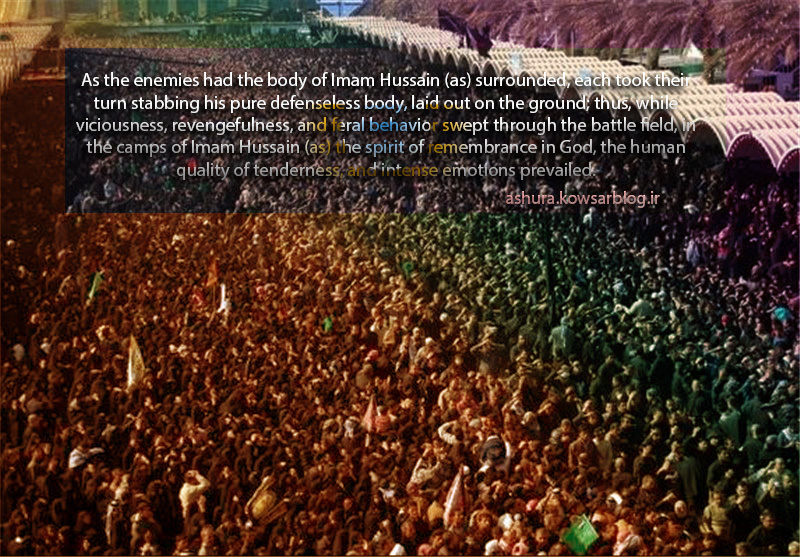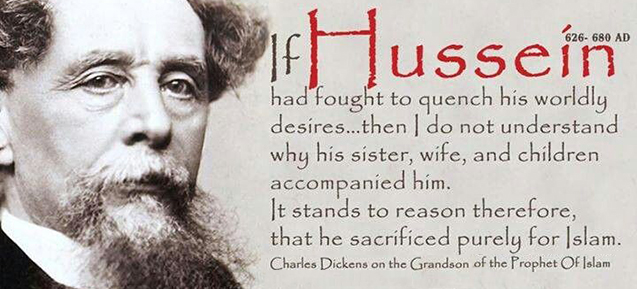Remember the day of Ashura

Ayatollah Khamenei
“Certainly, compared to other Muslim societies, one of the most important advantages of the Shiite society is the commemoration of Ashura Day.”
(6th June 1994)
ceremonies for Imam Hussein’s

Ayatollah Khamenei
“People must appreciate mourning ceremonies for Imam Hussein’s (Peace Be upon Him) martyrdom in order to create a spiritual connection to Imam Hussein (Peace Be upon Him), family of the Prophet (Peace Be upon Him), Islam and the Holy Qur’an.”
(6th June 1994)
The greatest blessing

Ayatollah Khamenei
“The blessed commemoration of Imam Hussein (Peace Be upon Him) is one of the greatest blessings bestowed by God for our Shiite Society i.e. mourning for this Imam in Muharram.”
(6th June 1994)
What was the purpose of Imam Hossein's uprising

What was the course of Imam Hussain’s (A) revolution? What reasons prompted him to initiate such a great and unmatched upspring? Did he intended to overthrow the Yazid regime? Did he wish to end the Umayyid dynasty? These and such other questions keep cropping in the mind and everyone wants to know the satisfactory replies, specially the mourner of Imam Hussain (A) are more eager in this regard.
When Imam Hussain (A) was preparing to leave on his longest journey,he bid adieu to the grave of his grandfather, the Holy Prophet (S.AW). Then he wrote a legacy addressing his brother Mohammed Bin Hanafiyyah in which he explained the aims and objectives of his uprising. We are quoting an extract from the same legacy hereunder. He wrote thus:
“And surely the aim of my stand is not inspired by vain exultation and it is also not for the quest of kingdom, Neither it is to cause dissension and corruption nor it is to wrong anybody unjustly.”
These sentences of Imam Hussain (A) are sufficient enough to beat all the criticisms and accusation leveled against him by theenemies of Islam and the enemies of Imam Hussain (A).) Now the question arises if these were not the motives of Imam’s uprising than why did he took stand? What were the aims of his uprising? Thus continued Imam Hussain (A)
“The purpose of my stand is the reformation of my grandfather’s nation. I intend to enjoin goodness and forbid evil. I want to emulate my grandfather, the Holy Prophet (S)and my father Alt Bin Abu Talib (A). Whosoever accepts me by accepting the truth, then Allah is higher than the truth. And whosoever rejects me then I will bear patiently until Allah adjudges between me and them and He is the best Judge.”
In this legacy the chief of martyrs has explained three purposes for his stand:
1- The reformation of his grandfather’s nation
2- Enjoining Good and Forbidding Evil
3- Renewal and Revival of the tradition of the Holy Prophet (S) and Imam Ali (A)
These purposes are not different than each other rather these are complementary to each other because, nation can be reformed only by means of bidding good and forbidding evil. The tradition and path of the Holy Prophet (S) and Imam Ali (A) is goodness and anything other than that is evil. Some facts are stated by Imam Husain (A) in his other sermons and letters but in other words. When he reached Mecca he wrote a letter to the people of Basra thus;
“I invite you towards the Book of Allah and the Sunnah of the Holy Prophet (S) because indeed Sunnah has been mutilated and hereby is revived. Whoever will accept my words, then I will guide him towards the straight path". (Tarikhe-Tabari vol.7, pg.240)
In another letter to the people of Kufa he wrote thus:
“By God, Imam is the one who acts on the commands of the Book, deals with Justice, followed the truth and reserves his self for the pleasure of Allah.”
These words of Imam imply that only he can be an Imam who possesses these characteristics and the one who does not possess them cannot be an Imam. Hence Yazid Bin Muawiyah has had no right to the caliphate. When he reached at ‘Baiza’, a place near Karbala and was besieged by the contingent of Hur, then he addressed his men and the army of Hur in these words:
“The one who sees a tyrant King who is making unlawful as lawful, violating the pledge (of God), opposing the Sunnah of the Holy Prophet (S) ruling on the servant of Allah with sins and oppression. And by his words and actions does not oppose the King and does not strive to reform the circumstances, then it behooves Allah to hurl him into Hell along with the King.”
Then he continued about the Yazidi regime thus:
“They have shun the obedience of Allah and acted following Shaitan. They are instigating commotion and dismissing the divine laws. They are expending from the public exchequer for their selfish end and are changing the prohibited things to permissible thing.”
In the first sermon at Karbala he spoke thus:
“Can’t you see that the truth is not followed and the falsehood is not shunned.? In such circumstances a believer should desire to meet Allah. Surely I regard death as nothing but an honour and life with Oppressors as anything but disgrace.” Tarikhe-Tabari, vol.-7pg.300)
Nevertheless the unique and unparalleled revolution of Imam Hussain (A) which began in Rajab 60 AH. and apparently ended with the glorious martyrdom of Imam Hussain (A), his kith, kin and companions was not in vain. The purpose of this revolution was to revive and rejuvenate Islam (which was distorted and Yazidi regime wanted to annihilate it), and also to reform the nation of the Holy Prophet (S). Some of the Sunni Traditionalists have added a phrase of ‘and on the path of Khulafa Rashedeen’. It is an addition made in the reign of Umayyid dynasty because the term ‘Khulafa-Rashedeen’ was coined by the Historians and Scholastic Theologians of that time and this term was not in use at the time of Imam Hussain (A).
Moreover, Imam Hussain (A) was critical about the behavioural pattern of the caliphs, then how he could have desired to follow their paths ?
The Revolution’s Causes imam hussain

The Revolution’s Causes
The
motives for revolution were numerous. Some were direct grievances of the
general people while others were ideological. The following were the
most apparent:
1. There were many defects and drawbacks but the most
urgent one was the attempt to distort Islamic concepts and ideals. This
aspect was of extreme importance and preoccupied the minds of
responsible Muslims at the time. The fabrication of Hadith was all too
common, which had a poisonous effect on the lives of Muslims. This, was
giving the Umayyads for a while a free hand to carry out their inhuman
deeds and policies. The mask of religion which they used to hide their
un-Islamic conduct was extremely dangerous. In the long run, this could
have changed Islamic concepts of ruling and inverted social ideals. Thus
stripping off this mask and exposing the true Umayad’s picture was of
utmost necessity.
2. The State’s structure was built on an un-Islamic
basis. Quraish was born to rule, Arabs were second class citizens, and
non-Arabs constituted the base of the society’s pyramid. That was the
general social picture of, the Muslim world under the Umayyads dynasty.
Freedom of thought and expression were denied, When one dared to express
an opinion contrary to that of the Umayyad’s, prison became his home,
his property was robbed, and oven his life was at stake.
3. The
Umayyads considered the Muslim world to be their own property. The aims
(Zakat) and other Islamic dues were collected, but no-one knows or can
question where that money went. Large gifts and donations were given to
few cruel governors and tribal chiefs in order to secure their
allegiance. Large sums of money were wastefully spent on racing,
gambling, wine-making, and buying slave women to entertain high-class
people in power. Hence, the majority of Muslims were left near
starvation level while the ruling group all enjoyed the social and
material privileges.
4. The Muslims had apparently got used to the
un-Islamic rule of the Umayyads as time passed by. Their resistance
slackened and some people began adjusting themselves to the new
conditions. Hence, the revolutionary spirit of Islam began to disappear
gradually from Muslims’ lives and thoughts. Therefore, a new stimulant
to their souls was necessary to activate their lives and try to restore,
Islamic conduct to the society.